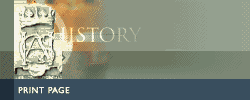|
The Flemish Origins
Because of its ancient traditions and
the sheer volume of international trade, the comte of Boulogne had
more sophistication, more wealth than Flanders. Ernicule of
Ponthieu, who married the heiress of the counts in 965, kept a
court at Boulogne which, in the words of a contemporary
chronicler, proceeded to arrogate to itself “les droits et les
prerogatives de l’autorites royale elle-meme”. His court, and that
of his desendants, was run with the help of a seneschal, an
advocate (or defender), a master of hunting, a constable, a
gonfanonier (or standard bearer), a marshal and a butler; and
supported by four chatelains, two under-counts (or viscounts), and
twelve barons. The whole formed an administrative council which
descended directly from the synodic pattern laid down by
Charlemagne.
The count of Boulogne himself, courted by all his peers, paying a
token homage to the count of Flanders but also a grand feudatory
of the King of France, was sovereign within his state. He had the
power of life and death over his subjects, and of peace or war
with his neighbours. He could fortify his own territories, wall
his towns, build castles, mint money. His ships could, and did,
sweep the Channel seas. Because of its geographical situation as
the gateway of Europe, Boulogne had long had an intimate knowledge
of the processes of money which bred wealth, and those customs
which must support the circulation of currency. Boulogne weights
and measures, like Boulogne coins, are well known to French
antiquaries.
The colours of Boulogne were the “or”
and “gules” of heraldry – in common language, gold and red. The
official emblem, that borne personally by the count, was or, three
torteaux gules – which is to say, three red balls on a yellow
ground.
This one unquestionable armorial device occurs soon afterwards in
the tapestry, where invading horsemen are meeting the unmounted
Saxons. The leading calvaryman (the gonfanonier?) carries a
bannered lance, and this time the flag is unmistakably ornamented
with the three red balls on a ground of gold borne by the counts
of Boulogne. So inherited devices of the kind we call heraldic
were known in 1066, and were carried at the Battle of Hastings.
But, permanently and irrevocably, the Conquest changed the system.
Domesday shows the huge grants made by William of Normandy to his
non-Norman allies. The English lands acquired by the Boulonnais
nobility would expect to follow the continental custom and have
their own territorial mark. Extra allegiances brought with them
the need for further explanatory devices. A younger son, founding
his own dynasty in a new land, would want his own symbol,
something individual and recognizable as his, but also plainly
derived from the parent pattern. For in the medival world a man’s
past was as important as his present; and it was necessary to
indicate with both clarity and precision not only who he was but
from where he had come. The resultant heraldic shake-up was to the
biggest since the division of Europe after Charlemagne’s death in
814. It’s effects in England are fascinating and informative; in
Scotland they are the very fabric of that nation’s history.
Like all European princes of the time, William the Conqueror was a
product of international breeding. He knew, from his wife, his
aunts, his grandmother, and the foreign nobles who attended them
at the Norman court, something of the manners and traditions of
the European aristocracy. The vast rewards he made to the
followers of Eustace of Boulogne must have been bestowed with
peculiar pleasure; the sometimes landless heirs of Charlemagne
would thus be placed permanently in his debt; pirate turned patron
was a pleasing role for this subtle and calculating man to play.
His protégés were also, most of them, his wife’s kinsmen.
more >
| 

